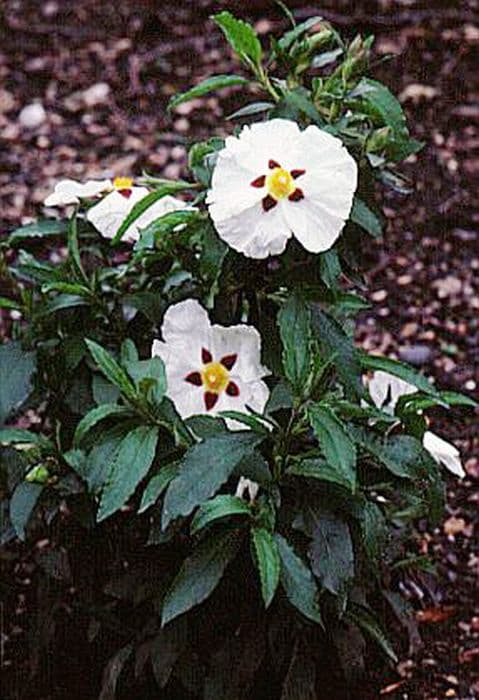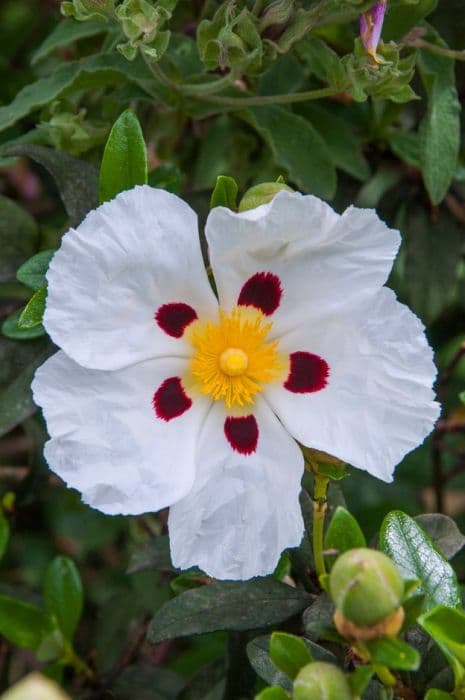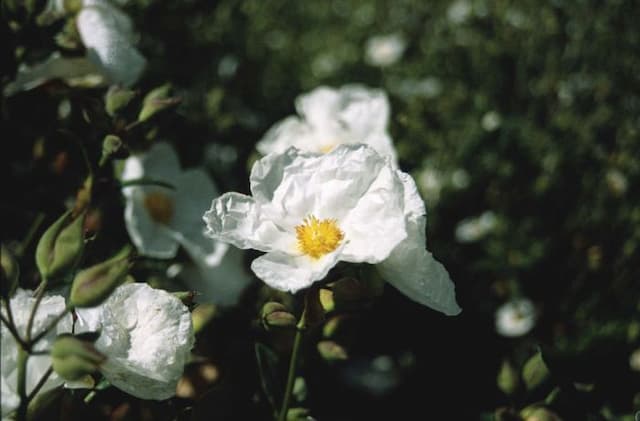Rock Rose Helianthemum 'Mrs C.w. Earle' (d)

ABOUT
'Mrs. C.W. Earle' is a variety of Rock Rose characterized by its vibrant and eye-catching flowers. The plant is known for its showy blooms which are a rich, deep yellow color, creating a striking contrast with the green foliage. Each bloom possesses a multitude of delicate petals radiating around a central mass of stamens. These blooms are notable for their papery texture and are often described as resembling tissue paper or crepe. The foliage of the Rock Rose 'Mrs. C.W. Earle' is equally appealing with its evergreen leaves providing year-round interest. The leaves are small, oval-shaped, and have a slight sheen, contributing to the plant's overall lush appearance. When in full bloom, the contrast of the golden yellow flowers against the backdrop of dark green leaves makes for a spectacular display. The Rock Rose is a low-growing plant that branches freely, forming a dense mat that covers the ground. The stems are slender and may become woody at the base as the plant matures. The overall effect is of a plant that is well-suited for rock gardens, borders, and areas where a touch of vibrant color is desired. The beauty of this plant lies in its dense flowering habit and the cheerful ambiance it brings to the garden space it occupies.
About this plant
 Names
NamesFamily
Cistaceae
Synonyms
Rock Rose, Sunrose
Common names
Helianthemum 'Mrs C.w. Earle'
 Toxicity
ToxicityTo humans
Rock rose is generally considered non-toxic to humans. However, it's always advisable to avoid ingesting plants that are not meant for consumption, as individual reactions may vary.
To pets
Rock rose is not known to be toxic to pets. Nonetheless, pets should not be encouraged to ingest ornamental plants as they can cause digestive upset or an unexpected allergic reaction.
 Characteristics
CharacteristicsLife cycle
Perennials
Foliage type
Evergreen
Color of leaves
Green
Flower color
Yellow
Height
1 foot (0.3 meters
Spread
2 feet (0.6 meters
Plant type
Shrub
Hardiness zones
5
Native area
Mediterranean
Benefits
 General Benefits
General Benefits- Attracts Pollinators: The plant is known to attract bees and butterflies, which are important for pollination.
- Drought Resistant: Helianthemum 'Mrs C.w. Earle', commonly known as Rock Rose, is highly tolerant of dry conditions once established.
- Low Maintenance: Rock Rose is an easy-to-care-for plant that does not need frequent watering or fertilizing once established.
- Ground Cover: With its spreading habit, it's excellent for covering bare spots and controlling erosion.
- Decorative Blooms: Rock Rose produces attractive flowers that enhance garden aesthetics.
- Sun Tolerance: The plant thrives in sunny locations, making it suitable for sunny gardens and landscapes.
- Wildlife Habitat: It provides shelter and food for various small creatures and insects.
- Long Blooming Period: The Rock Rose often has a lengthy blooming season, offering color for an extended time.
- Versatile Use: Suitable for rock gardens, borders, and as a specimen plant due to its attractive form and blooms.
 Medical Properties
Medical PropertiesThis plant is not used for medical purposes.
 Air-purifying Qualities
Air-purifying QualitiesThis plant is not specifically known for air purifying qualities.
 Other Uses
Other Uses- Artistic inspiration: The vibrant blooms of the Rock Rose can serve as a compelling subject for painters and photographers, capturing the beauty of the plant in various art forms.
- Culinary decoration: The flowers of the Rock Rose can be used to adorn cakes or desserts, adding a touch of elegance to the presentation of culinary dishes.
- Educational tool: The plant can be used in botanical studies to illustrate various topics such as xeriscaping, pollination, or the adaptation of plants to arid environments.
- Dye source: The petals of the Rock Rose may be used to produce a natural dye for fabrics or crafting, although this is not a common use.
- Pressed flower crafts: The blooms can be pressed and preserved, then used in crafting activities like making bookmarks, greeting cards, or decorative framed art.
- Horticultural training: The Rock Rose, due to its hardiness, can be used in horticultural courses to teach plant care and propagation techniques.
- Soil erosion control: When planted on slopes or areas prone to erosion, the Rock Rose can help stabilize the soil with its root system.
- Companion planting: The Rock Rose can be planted alongside vegetable gardens to attract pollinators, thus benefiting the pollination of nearby crops.
- Garden design: The Rock Rose is used in rock gardens or alpine landscapes to create naturalistic or mountainous effects within garden designs.
- Theme gardens: This plant can be a part of theme gardens, such as Mediterranean or drought-tolerant gardens, due to its origin and low water requirements.
Interesting Facts
 Feng Shui
Feng ShuiThe Rock Rose is not used in Feng Shui practice.
 Zodiac Sign Compitability
Zodiac Sign CompitabilityThe Rock Rose is not used in astrology practice.
 Plant Symbolism
Plant SymbolismHelianthemum 'Mrs C.W. Earle' is commonly known as Rock Rose. Here is a list of its symbolic meanings in HTML format:
- Survival: Rock Rose symbolizes survival and endurance due to its ability to thrive in rocky, challenging environments.
- Beauty and Resilience: It reflects the notion of beauty amidst adversity, as the plant produces stunning flowers even in harsh soil conditions.
- Protection: In some traditions, the Rock Rose is thought to symbolize a protective barrier against negative influences, much like its hardy nature in the wild.
- Healing: The plant is often associated with healing properties, both physically in herbal medicine and metaphorically in overcoming emotional challenges.
 Water
WaterRock Roses, like Helianthemum 'Mrs C.w. Earle,' prefer to be watered deeply but infrequently, ensuring that the soil is allowed to dry out between waterings. During the growing season, they might need water once every week, depending on the climate and weather conditions. Aim to provide about one to two gallons of water to the soil surrounding the plant, which should suffice to reach the roots without causing waterlogging. In the winter or cooler months, reduce watering frequency as the plant’s water requirements diminish. Always check the top couple of inches of soil for dryness before watering again to avoid overwatering.
 Light
LightRock Roses, including Helianthemum 'Mrs C.w. Earle,' thrive in full sunlight, so it is best to locate them in a spot where they will receive at least six hours of direct sunlight daily. These plants perform well in bright, unfiltered light which ensures optimal growth and flowering. Avoid placing them in deep shade or heavily filtered light as this can lead to poor blooming and a leggy plant form.
 Temperature
TemperatureRock Roses such as Helianthemum 'Mrs C.w. Earle' are hardy and can tolerate a wide range of temperatures but they grow best when the temperature is between 60 and 70 degrees Fahrenheit. They can withstand minimum temperatures down to about 10 degrees Fahrenheit, making them suitable for many temperate climates. However, in extremely high temperatures, it is important to ensure that they have adequate water to prevent stress.
 Pruning
PruningRock Roses, including Helianthemum 'Mrs C.w. Earle,' benefit from pruning to maintain a compact shape and to encourage bushier growth. Prune in early spring, just as new growth begins, removing any dead or damaged branches and cutting back up to one-third of the previous year's growth. This timing allows the plant to quickly recover and produce fresh foliage and blooms. Pruning can also be done after the first flowering period to promote a second bloom in the same season.
 Cleaning
CleaningAs needed
 Soil
SoilRock rose (Helianthemum 'Mrs C.w. Earle') does best in well-draining soil with plenty of grit or sand mixed in to improve drainage. A balanced mix containing two parts loam, one part sand or grit, and one part peat or humus is ideal. The pH should be neutral to slightly alkaline, between 6.5 and 7.5.
 Repotting
RepottingRock rose (Helianthemum 'Mrs C.w. Earle') typically doesn't require frequent repotting and can be done every two to three years or when the plant appears to outgrow its current pot. This is usually noticeable by roots peeking out of the drainage holes or a slowdown in growth.
 Humidity & Misting
Humidity & MistingRock rose (Helianthemum 'Mrs C.w. Earle') prefers low to moderate humidity conditions and is fairly tolerant of dry air. It is well-suited to typical outdoor humidity levels but can also adapt to indoor conditions if not overly humid.
 Suitable locations
Suitable locationsIndoor
Ensure bright light, avoid waterlogging, minimal indoor humidity.
Outdoor
Full sun, well-drained soil, protect from severe frost.
Hardiness zone
5-9 USDA
 Life cycle
Life cycleThe life cycle of Helianthemum 'Mrs C.W. Earle', commonly known as Rock Rose, begins with seed germination, triggered by warm temperatures and sufficient moisture. The seedlings develop into young plants, establishing a root system and producing small, woody, evergreen shrubby foliage with needle-like leaves. As the plant matures, it enters the flowering stage, usually in late spring or early summer, showcasing its showy, saucer-shaped, rose-like flowers in shades of bright yellow, orange, or pink. After pollination, typically involving bees and other insects, the flowers produce small, dry seed capsules that release seeds when mature, ensuring the propagation of the next generation. During the autumn and winter, the plant may enter a dormant phase, especially in colder climates, with reduced growth and metabolic activity to conserve energy. The Rock Rose is a perennial plant and will repeat this cycle annually, with a lifespan that can span several years under suitable growing conditions.
 Propogation
PropogationPropogation time
Spring-Early Summer
Propogation: Helianthemum 'Mrs C. W. Earle', commonly known as rockrose, is typically propagated by semi-ripe cuttings. The most popular method takes place in summer when the plant's new growth has begun to harden. Cut a 4 to 6-inch length (which is approximately 10 to 15 centimeters) from the semi-ripe stem, ensuring the cutting includes a heel if possible. Remove the lower leaves and dip the base into rooting hormone to improve success rates. Plant the cutting into a mixture of sand and peat, ensuring that it is well-draining, and place it in a shaded, sheltered area. Keep the soil moist until roots develop, which is usually within a few weeks, after which the new rockrose plants can be gradually acclimatized to sunnier conditions and eventually transplanted into the garden.









